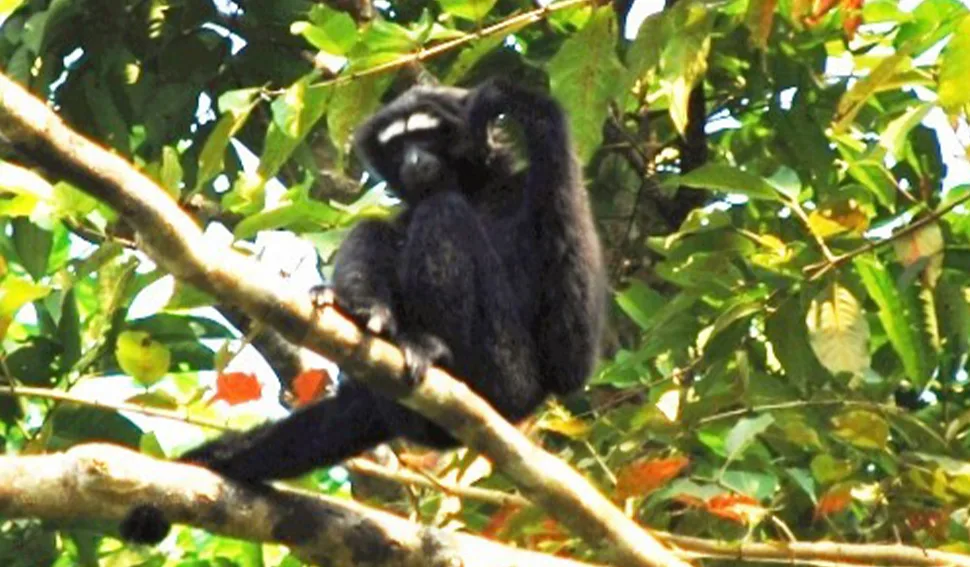Gaurav Gogoi opposes plan for oil and gas exploration in Assam’s hoolock gibbon habitat, writes to Union Minister

Congress MP from Jorhat, Gaurav Gogoi, has expressed strong opposition to the Assam forest department’s approval of Vedanta Ltd’s plan for exploratory oil and gas drilling in the Hollongapar Gibbon Wildlife Sanctuary, which could jeopardize the habitat of the endangered hoolock gibbon, a species already at risk.
Gogoi argues that drilling could have detrimental effects on the sanctuary’s ecosystem and the gibbons’ survival.
The Assam forest department has approved the diversion of 4,499.8 hectares of forest land within the eco-sensitive zone of the Hollongapar Gibbon Wildlife Sanctuary in Jorhat district for oil and gas exploration by Vedanta Ltd. The specific area in question is the well pad SP-1East-2 in the AA-ONHP block.
In a letter to Union Minister for Environment, Forest and Climate Change, Bhupender Yadav, Gogoi said: “I express my deep concern about the proposed oil and gas exploration project by Vedanta in the eco-sensitive zone of the Hollongapar Gibbon Wildlife Sanctuary in Jorhat. This sanctuary is a critical habitat for the endangered Hoolock Gibbon. The Assam Forest Department’s recommendation to grant forest clearance for the project, even with conditions, is deeply troubling.”
“While I understand the potential economic benefits of the project, these cannot come at the expense of our natural heritage and endangered wildlife. The Hollongapar Gibbon Wildlife Sanctuary is home to a unique and irreplaceable ecosystem. The project’s potential impact on this ecosystem, including deforestation and pollution, is simply too great. I urge you to reconsider the Assam Forest Department’s recommendation and reject any plans that would endanger the sanctuary or its inhabitants,” Gogoi added.
Despite the Forest Advisory Committee (FAC) of the Ministry of Environment, Forest and Climate Change (MoEFCC) deferring its decision, the project for exploratory oil and gas drilling by Vedanta Ltd has already received approval from both the Assam forest department and the regional office of the MoEFCC.
According to the minutes of the FAC meeting dated July 4, the project has been greenlit at the state and regional levels, allowing for the diversion of 4,499.8 hectares of forest land within the eco-sensitive zone of the Hollongapar Gibbon Wildlife Sanctuary.
Wildlife activist and journalist Apurba Ballav Goswami has expressed concerns about the impact of the proposed oil and gas drilling in the Hollongapar Gibbon Wildlife Sanctuary. Goswami emphasized that the hoolock gibbon is a canopy dweller, meaning it relies heavily on the continuous canopy cover of the forest for its habitat and survival. According to Goswami, even minor disruptions or breaks in this canopy could pose serious risks to the gibbons, affecting their safety, movement, and overall well-being.
The FAC has suggested that the state government obtain comments from the Principal Chief Conservator of Forests (PCCF) or the Chief Wildlife Warden (CWW) regarding Cairn India’s proposal and said these comments, which should include a wildlife conservation plan, be considered from a conservation perspective.
The Divisional Forest Officer (DFO) of the Jorhat Forest Division noted in Part-II of the environmental assessment form that the area affected by the project is home to various wildlife species, including elephants, hoolock gibbons, and leopards. However, the DFO also stated that the project area is relatively small and that no major construction is anticipated.
“Hence the impact will be minimal and, if necessary, a wildlife management and mitigation plan shall be prepared and all precautions shall be taken to cause minimal disturbance to wildlife and to mitigate man-animal conflict,” he added.
The story about the project in the Hollongapar Gibbon Wildlife Sanctuary surfaced shortly after the Anil Agarwal Foundation signed an agreement with Kaziranga National Park and Tiger Reserve (KNPTR). Under this agreement, the Foundation has pledged Rs 6 crore over three years to support the conservation of rare wildlife species in Kaziranga National Park.

Leave a Reply